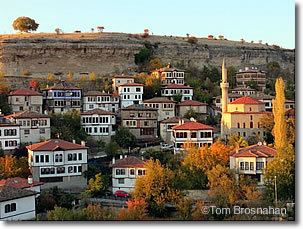Criteria ii, iv, v Area 1,000 km² Area code 370 | Type Cultural Reference 614 Local time Tuesday 3:03 AM UNESCO World Heritage Site inscription 1994 | |
 | ||
UNESCO region Europe and North America Weather 1°C, Wind N at 0 km/h, 88% Humidity Points of interest Kent Tarihi Müzesi, Kaymakamlar Gezi Evi, Eski Çarşı, Tarihi Cinci Hamamı, Safranbolu Saat Kulesi | ||
Safranbolu karabuk introduction film
Safranbolu (Greek: Σαφράμπολις, Saframpolis) is a town and district of Karabük Province in the Black Sea region of Turkey. It is about 9 km north of the city of Karabük, 200 kilometres (120 mi) north of Ankara and about 100 km south of the Black Sea coast. The town's historic names in Greek were Theodoroupolis (Θεοδωρούπολις, i.e. city of Theodorus or female Theodora) and later Saframpolis (Σαφράμπολις). Its former names in Turkish were Zalifre and Taraklıborlu. It was part of Kastamonu Province until 1923 and Zonguldak Province between 1923 and 1995.
Contents
- Safranbolu karabuk introduction film
- Map of Safranbolu 78600 Safranbolu2FKarabC3BCk Turkey
- Sister cities
- Notable natives
- References
Map of Safranbolu, 78600 Safranbolu%2FKarab%C3%BCk, Turkey
According to the 2000 census, the population of the district was 47,257, of which 31,697 lived in the town of Safranbolu. The district covers an area of 1,000 km2 (386 sq mi), and the town lies at an elevation of 485 m (1,591 ft).
The Old Town preserves many historic buildings, with 1008 registered historical artifacts. These are: 1 private museum, 25 mosques, 5 tombs, 8 historical fountains, 5 Turkish baths, 3 caravanserais, 1 historical clock tower, 1 sundial and hundreds of houses and mansions. Also, there are mounds of ancient settlements, rock tombs and historical bridges. The Old Town is situated in a deep ravine in a fairly dry area in the rain shadow of the mountains. The New Town can be found on the plateau about two kilometers west of the Old Town.
The name of the town derives from "saffron" and the Greek word polis (πόλις) meaning "city", since Safranbolu was a trading place and a center for growing saffron. Today, saffron is still grown at the village of Davutobası to the east of Safranbolu, with a road distance of 22 kilometres.
Safranbolu was added to the list of UNESCO World Heritage sites in 1994 due to its well-preserved Ottoman era houses and architecture.
